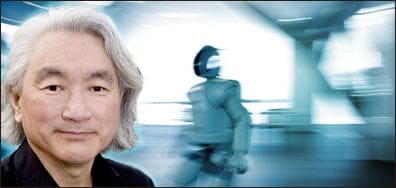Visions of the Future
Written and presented by Michio Kaku
Three-part television series on BBC 4
Starts on Monday 5 November, 9–10 p.m.

Michio Kaku’s day job is a string theorist at City College of New York, and he is well known as a popularizer of theoretical physics with books such as Hyperspace and Parallel Worlds. But in his new three-part series Visions of the Future, Kaku widens his remit to futurist, taking a whistle-stop tour around the scientific developments that he thinks will revolutionise our lives in the 21st century. Kaku certainly looks the part of a visionary, with his flowing white hair and beatnik all-black outfits. But is he really wise enough to see the future where others have ended up looking foolish?
The series is based on Kaku’s 1997 book Visions, for which he interviewed 150 scientists, including several Nobel laureates, in an attempt to find consensus about where science was going in the next 100 years. The thesis of both the book and the series is that the 20th century was the ‘age of discovery’, when humanity first understood the atom, the gene and the computer. By contrast, the 21st century will be the ‘age of mastery’, when we gain the ability to control matter, life and intelligence to our advantage.
In the first installment, “The Intelligence Revolution”, Kaku boldly predicts that “the exponential growth of computer power will profoundly reshape all of human civilization”, ignoring arguments that Moore’s Law can’t be maintained indefinitely. But perhaps that is not surprising when a frequently appearing talking head is that of ‘inventor and futurist’ Ray Kurzweil, who first transformed Moore’s Law from a specific prediction of transistor sizes to an observation about technology in general. Indeed, the series relies quite heavily on contributions from ‘technology forecasters’, authors and ‘virtual reality pioneers’, who seem prepared to stick their necks out further than the plain old scientists he interviews.
Kaku spends a lot of time talking about the online social networks and virtual worlds that have sprung up since his book was published. In one hilarious sequence an avatar of a younger Kaku, though still kitted out in black, flies through the virtual landscape of Second Life. But Kaku thinks the really profound changes will occur in the second half of the century, as we create machines that rival human intelligence while also learning to enhance our own cognitive powers. One of the most thought-provoking sequences in the series shows a clinically depressed patient’s face light up with a grin under the influence of ‘deep brain stimulation’ – a kind of pacemaker for the brain.
Part 2, “The Biotech Revolution”, sees Kaku explain how we will achieve mastery over life itself, with the rather familiar examples of genetic screening and the synthesis of artificial body parts. Kaku’s description of gaining the ability to control evolution as being “literally able to play God” would probably make Richard Dawkins squirm. But his fervent hope that we will be able to eliminate the Alzheimer’s disease that killed his father and now afflicts his mother is touching.
Then it’s on to “The Quantum Revolution”. I was expecting to hear about the potential of quantum information for computing and cryptography, recently dubbed ‘spookytechnology’ by Cambridge physicist Charles Tahan. But in fact, things only get spooky in the last few minutes of the show, when Kaku visits Anton Zeilinger’s Vienna lab to see photons teleporting (before confidently asserting that we will teleport a molecule in a few years and a virus within a decade). Instead, this show is a ragbag of hot physics topics from metamaterials to nanotubes; nuclear fusion to personal fabrication. University of Manchester particle physicist Brian Cox adds to his tally of media appearances, though he might find himself out of a job if Kaku’s statement that “atoms are the fundamental building blocks of everything we see” were true.
There is a strangely retro feel to many of Kaku’s visions, which is only added to by the use of clips from black and white sci-fi films. In Part 3 we get the space elevator, conceived in 1895 but revived with the promise of super-strong carbon nanotubes, the invisibility cloak, and even that futurist staple the flying car. Kaku is whole-heartedly a technological optimist, and though he gives air time to the ethical issues raised by new technology (with brain researcher Susan Greenfield often acting as the conscience of the series) he dismisses them soon after. Super-intelligent robots could take over the world? We’ll be able to choose their level of advancement to suit us. Nanobot weapon systems go out of control? Kaku thinks we’re smart enough to build safeguards, and that the benefits far outweigh the risks.
Indeed, Kaku believes that ultimately the ability of humanity to travel into space and see Earth from outside will vanquish all divides along religious, ethnic and national lines. I wish I could share his optimism, but in the end I found Visions of the Future unconvincing. In this gadget shop guide to the 21st century there are too many ‘wow’ moments and not enough attempts to explain the real science behind them.



